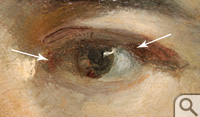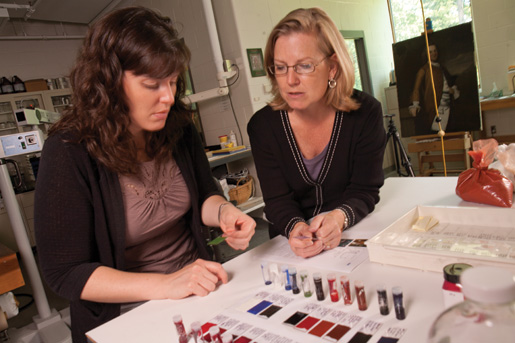The chemist and the conservator
They work together to trace molecular "fingerprints" of rare pigments
Shelley Svoboda uses a fine surgical blade to take pigment samples from 18th-century paintings. She used to tell visitors to her lab at the Colonial Williamsburg Foundation that she only needed to remove a piece smaller than the period at the end of this sentence.
She doesn’t say that now. You can see the period at the end of this sentence, but you can’t see anything as small as the amount now needed to do scientific analysis of pigment—at least not with the naked eye.
“The idea, especially with these historic paintings, has always been to remove a minimal amount of paint,” explains Svoboda, a Colonial Williamsburg conservator specializing in paintings. A collaboration with Kristin Wustholz, assistant professor of chemistry at William & Mary, has produced a new technique that allows precise chemical analysis from a single near-microscopic particle excised from the painting.
The technique uses a laser microscopy method known as surface enhanced Raman scattering (SERS). Much like the objects of their study, 18th-century portraitists who prepared their own paints, Wustholz and the students in her lab begin their work by mixing a paste of silver-colloid nanoparticles.
“You place the silver nanoparticles on the paint sample you want to analyze,” Wustholz explained. Then the sample goes onto a glass slide and into the SERS laser. The molecules in the sample react to the laser, vibrating and scattering the light. The pattern of the scattered light is diagnostic for the substance being analyzed.
Looking for fingerprints
“The silver nanoparticles act as an antenna, essentially. It gives you a very strong signal, like a fingerprint, almost,” she said.
That “fingerprint” is the vibrational spectra unique to the molecules in the paint. Wustholz can compare the fingerprint of the sample to a database of known vibrational spectra of pigments.
Wustholz’s SERS laser approach is a great improvement over conventional Raman spectroscopy, until now the go-to protocol for paint analysis. “Raman spectroscopy is great. It provides you with the vibrational fingerprint. The problem is that it’s incredibly insensitive; only about one in a million photons will be Raman scattered,” she explained—thus the need for the larger sample to be taken from the painting.
The chemists correlate SERS work with a second examination of the paint, using fluorescence microscopy. The two-pronged approach, Wustholz says, gives a superbly accurate and detailed fingerprint of paints.
Wustholz describes the SERS process as “minimally invasive,” while fluorescence is completely nondestructive; it even can be done at a distance. These attributes are a godsend to a conservator of paintings such as Svoboda. The two—along with two of Wustholz’s undergraduates—collaborated on a study of pigments used in two 18th-century portraits that were in Svoboda’s lab. The collaboration led to a paper in the scientific journal Analytical Chemistry, with Wustholz’s students Stephen Dinehart ’12 and Lindsay Oakley ’12 as co-authors.
“Both of those paintings are from about the same era, but one is by Sir Joshua Reynolds—the biggest name in painting in London at the time. Robert Feke is an American, the first American-born painter,” Svoboda explained. “Feke is actually a little earlier than the Reynolds, 1748— but we found that they both were using the same materials, most probably British.”
In their examination of Reynolds’ Portrait of Isaac Barré and Feke’s Portrait of William Nelson, the team was searching for the molecular fingerprints of colorants known as lake pigments. They were especially interested in finding evidence of a prized—and quite expensive—red pigment known as carmine lake.
 Red pigment = red flag
Red pigment = red flag
Svoboda explains that lake pigments are organic dyes compounded into a mineral carrier. In the case of carmine lake, the dye comes from the scales of a particular insect. She said that lake pigments, much valued by 18th-century painters for their “beautiful, luminous colors,” raise a luminous red flag when today’s art professionals suspect their presence.
“They are more prone to damage from light fading,” she said, “and we can’t share the paintings with the visitor without light.” Svoboda says museums have developed exhibition techniques for protecting light-vulnerable works by displaying them with minimal illumination.
Both carmine lake and another red pigment, madder lake, present fading concerns, Svoboda said. Red colorants weren’t only used to paint red coats and the like; they were commonly mixed with—or used on top of—other colorants to produce flesh tones. “It gives a vitality and translucency that the artists found nothing else could contribute,” she said, but it’s often been difficult to do more than suspect the presence of carmine lake, especially if you allow for three centuries of potential sun damage.
Isaac Barré’s portrait was put to the new minimally invasive SERS protocol. Viewing the painting’s surface underneath the floor microscope in her lab, Svoboda plied her surgical blade in two areas, taking tiny samples. Feke’s William Nelson got the same treatment.
“I just break through the varnish with a very small action of the blade,” Svoboda says. “With a good blade you can slice through a single large pigment grain, and the naked eye can’t even see the cut in the varnish.”
SERS microscopy can find the molecular fingerprint of even faded pigments. Wustholz and Svoboda had good reason to suspect carmine lake in the Portrait of Isaac Barré; Sir Joshua Reynolds maintained detailed notes on his technique and paint preparation. The paints Feke used represented more of an unknown quantity.
 Wustholz took the samples to her lab in William & Mary’s Integrated Science Center, where she got Dinehart and Oakley started on the nanoparticle prep and the microscopy.
Wustholz took the samples to her lab in William & Mary’s Integrated Science Center, where she got Dinehart and Oakley started on the nanoparticle prep and the microscopy.
“When we first looked at the sample, we just saw some kind of red pigment,” Oakley said. “We suspected it was probably either carmine lake or madder lake.”
It was a while before the students caught onto the feel of the SERS laser microscope (“It’s like learning to drive,” Wustholz says.)
“We have to move the sample around and try to find the best spot that will give a high intensity spectrum,” Dinehart explained. “It takes a lot of luck and a lot of maneuvering. We’ve spent hours back there just moving one tiny sample around trying to find the perfect fingerprint.”
The fingerprints—verified by fluorescence microscopy—verified presence of carmine lake in the flesh of the Reynolds portrait, as Svoboda suspected. “The art history record shows that Reynolds’ flesh has faded in many paintings that we know of, sometimes very early,” she said. “But it’s been very hard to definitively identify the lake, because many analytical techniques require a fairly good sized sample. Until now.”
A surprising find
The analysis also showed that Feke used carmine lake in his Nelson portrait, a bit of a surprise in a work by a Colonial painter. Svoboda said that a Colonial apothecary could have been a source of the high-priced colorant.
The ability to identify positively a pigment provides a number of benefits. Curators can take appropriate measures when hanging especially vulnerable works. Svoboda and other conservators can work with more assurance when they know the pedigree of the pigments on their canvasses.
The chemist and the conservator are now working together to identify colorants in Colonial Williamsburg’s Carolina Room, a relocated 1830s parlor that’s a conservation treatment in progress.
“SERS, to me, is a magical thing,” Svoboda said. “It just opens up a whole avenue of study in these faces of history.” In turn, the chemists take pleasure in working on a project that generates interest outside of the lab.
“If I tell my family that I’m synthesizing silver nanoparticles, they don’t really care,” Dinehart said, “but if I can tell them that I’m working with the Colonial Williamsburg Foundation on a three-hundred-year-old painting, then people get a little more excited about it.” ![]()















